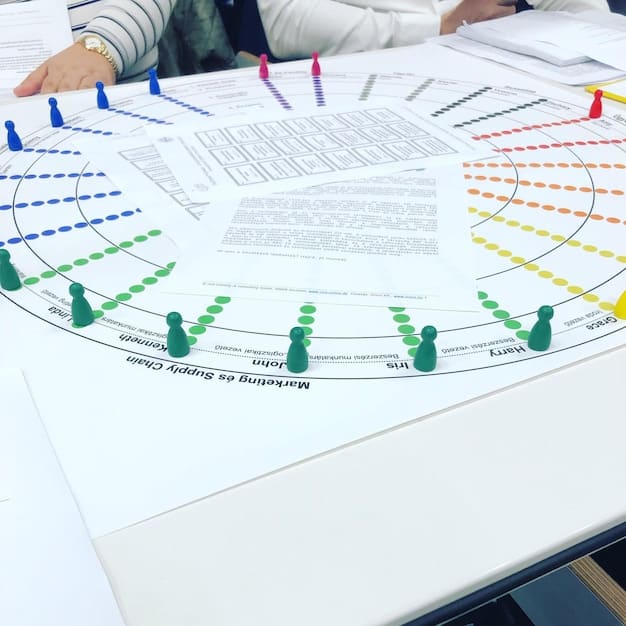How to Establish an AI Ethics Committee: A US Company Guide

Establishing an AI ethics committee is crucial for US companies to navigate the complex ethical landscape of artificial intelligence, ensuring responsible development and deployment.
Navigating the complexities of artificial intelligence requires more than just technical expertise; it demands a strong ethical framework. This guide, How to Establish an AI Ethics Committee: A Step-by-Step Guide for US Companies, will help your organization ensure responsible AI development and deployment.
Why Your Company Needs an AI Ethics Committee
In today’s rapidly evolving technological landscape, artificial intelligence is transforming industries and reshaping the way we live and work. However, with great power comes great responsibility. The deployment of AI technologies raises critical ethical questions that US companies must address proactively.
An AI ethics committee provides a structured and dedicated forum for identifying, evaluating, and mitigating potential ethical risks associated with AI. It ensures your company not only complies with emerging regulations but also builds trust and fosters innovation.
Addressing Ethical Concerns in AI
AI systems can perpetuate biases present in their training data, leading to discriminatory outcomes. An ethics committee can help identify and mitigate these biases, ensuring fairness and equity.
AI-powered surveillance technologies raise concerns about privacy and civil liberties. An ethics committee can establish guidelines for responsible data collection and usage.
- Bias Mitigation: Identifying and addressing biases in AI algorithms and datasets.
- Privacy Protection: Ensuring responsible data collection, storage, and usage practices.
- Transparency and Explainability: Promoting transparency in AI decision-making processes.
- Accountability: Establishing clear lines of responsibility for AI systems and their outcomes.
By establishing an AI ethics committee, US companies demonstrate a commitment to responsible innovation and build a sustainable future for AI.

Step-by-Step Guide to Forming Your Committee
Creating an AI ethics committee may seem daunting, but with a structured approach, any US company can establish a robust and effective body. This step-by-step guide offers a clear path to success.
From defining the committee’s mission to selecting the right members and establishing clear operating procedures, each step is crucial to ensuring the committee’s effectiveness and impact. Let’s dive in.
Define the Committee’s Mission and Scope
Begin by clearly defining the AI ethics committee’s mission, scope, and objectives. What specific ethical challenges will the committee address? What areas of the organization will it oversee?
A well-defined mission statement provides focus and direction for the committee’s activities.
Recruit Diverse and Knowledgeable Members
The success of your AI ethics committee hinges on the quality and diversity of its members. Seek individuals with a range of expertise and perspectives, including:
- Technical Experts: Data scientists, AI engineers, and software developers.
- Ethicists: Professionals with expertise in moral philosophy and ethical frameworks.
- Legal Counsel: Attorneys specializing in data privacy, AI regulations, and compliance.
- Business Leaders: Executives with insight into the organization’s strategic goals and risk tolerance.
A diverse committee will be better equipped to identify and address the multifaceted ethical challenges of AI.
Ensure a diversity of backgrounds and experiences; include people from different departments within the company to provide many different perspectives.
Establishing Clear Operating Procedures
A well-defined set of operating procedures is essential for the AI ethics committee to function effectively. These procedures should outline how the committee will:
Without clear guidelines, the committee may struggle to reach consensus or implement its recommendations effectively.
Develop Ethical Guidelines and Frameworks
The AI ethics committee should develop a comprehensive set of ethical guidelines and frameworks to guide the organization’s AI development and deployment. These guidelines should address key ethical principles, such as:
These guidelines should be developed in consultation with stakeholders and regularly updated to reflect evolving ethical standards and technological advancements.
Implement a Review Process for AI Projects
Establish a clear review process for all AI projects, ensuring that ethical considerations are integrated into every stage of the development lifecycle. This process should include:
- Ethical Risk Assessment: Identify potential ethical risks associated with the project.
- Mitigation Strategies: Develop strategies to mitigate these risks.
- Ongoing Monitoring: Continuously monitor the project for ethical concerns.
- Reporting Mechanisms: Establish clear reporting channels for ethical violations.
By integrating ethics into the AI development process, companies can proactively prevent ethical harms.

Training and Education for Staff
Once your AI ethics committee is up and running, your work is not done. To create a truly ethical culture within your organization, it is crucial to invest in training and education for all employees.
Education equips employees with the knowledge and skills to identify and address ethical concerns related to AI.
Workshops and Seminars on AI Ethics
Offer regular workshops and seminars on AI ethics to educate employees about key ethical principles, emerging regulations, and best practices.
These educational activities equip employees with the skills to identify and address ethical concerns related to AI.
Develop a Code of Conduct for AI
By involving employees in the development process, organizations can foster a sense of ownership and commitment to ethical AI practices. The code of conduct should cover topics such as:
- Data privacy and security
- Bias and fairness
- Transparency and explainability
- Accountability and responsibility
An AI code of conduct demonstrates to employees, customers, and the public that your company is committed to responsible AI innovation.
Monitoring and Evaluation of Committee Effectiveness
An AI ethics committee is not a “set it and forget it” endeavor. Regularly assess the committee’s effectiveness with a few key metrics. Consider regular internal surveys to gauge employee awareness levels.
Regular monitoring and evaluation provide valuable insights into the committee’s strengths and weaknesses.
Metrics for Success
Establish key performance indicators (KPIs) to measure the success of your AI ethics committee. These metrics may include:
The number of ethical concerns raised and addressed effectively
Independent Audits
Consider conducting periodic independent audits of your AI ethics program to identify areas for improvement and ensure that it aligns with best practices. An outside perspective is often helpful.
- Effectiveness of Ethical Guidelines: Are the guidelines comprehensive and effective?
- Compliance with Regulations: Is the organization complying with relevant AI regulations?
- Stakeholder Feedback: What do employees, customers, and other stakeholders think of the AI ethics program?
- Industry Benchmarking: How does the organization’s AI ethics program compare to those of its peers?
Use the audit findings to improve your AI ethics program and enhance its effectiveness over time.
Evolving with the Landscape
Artificial intelligence is a rapidly evolving field, and ethical considerations are constantly emerging. Your AI ethics committee must be adaptable and responsive to these changes.
Adaptability equips your organization to navigate the dynamic ethical landscape of AI and maintain its commitment to responsible innovation.
Stay Abreast of Emerging Trends
Encourage committee members to stay informed about the latest developments in AI ethics, including:
By staying informed, the committee can anticipate and address emerging ethical challenges proactively .
Engage with External Stakeholders
Engage with external stakeholders, such as academic researchers, industry experts, and civil society organizations, to gather diverse perspectives and insights on AI ethics. This offers further insight.
- Attend Industry Conferences: Keep up with the latest AI ethics trends.
- Join Online Communities: Participate in discussions with other AI ethics professionals.
- Follow Thought Leaders: Stay informed about the latest research and insights.
Engaging with the broader AI ethics community can help your organization stay at the forefront of responsible AI innovation.
| Key Aspect | Brief Description |
|---|---|
| ✅ Mission Definition | Clearly define the committee’s goals and scope. |
| 🧑🤝🧑 Member Recruitment | Recruit a diverse group with relevant expertise. |
| ⚙️ Procedure Setup | Establish clear guidelines for project review. |
| 📊 Monitoring & Evaluation | Regularly assess the committee’s effectiveness. |
Frequently Asked Questions
▼
The primary goal is to ensure the ethical development and deployment of AI technologies within a company. This includes identifying and mitigating potential risks related to bias, privacy, and fairness.
▼
Ideally, an AI Ethics Committee should include a diverse group of individuals with expertise in various fields, such as data science, ethics, law, and business leadership, to offer comprehensive perspectives.
▼
Meeting frequency depends on the volume and complexity of AI projects. Initially, meeting monthly or quarterly may suffice, increasing as needed to address ethical concerns promptly.
▼
Key ethical considerations include ensuring fairness and avoiding bias, protecting data privacy, maintaining transparency and explainability, and establishing accountability for AI systems’ decisions and actions.
▼
Companies can establish robust data governance policies, conduct regular compliance audits, engage with legal experts, and stay informed about evolving AI regulations and guidelines in their respective jurisdictions.
Conclusion
By following this comprehensive guide, US companies can establish effective AI ethics committees that promote responsible innovation, build trust, and navigate the complex ethical landscape of artificial intelligence. Embracing these principles is not just a matter of compliance but a strategic imperative for long-term success.





